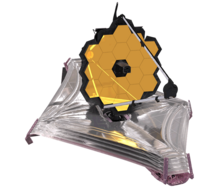
Back James Webb-ruimteteleskoop Afrikaans Telescopio espacial James Webb AN مقراب جيمس ويب الفضائي Arabic طيليسكوپ دجيمس ويب ARY জেম্ছ ৱেব স্পে’চ টেলিস্কোপ Assamese Telescopiu espacial James Webb AST Ceyms Vebb teleskopu Azerbaijani Téléskop Antariksa James Webb BAN Джэймс Уэб (тэлескоп) Byelorussian Джеймс Уеб (телескоп) Bulgarian
 Rendering of the fully deployed James Webb Space Telescope | |
| Names | Next Generation Space Telescope (NGST; 1996–2002) |
|---|---|
| Mission type | Astronomy |
| Operator | STScI (NASA)[1] / ESA / CSA |
| COSPAR ID | 2021-130A |
| SATCAT no. | 50463 |
| Website | jwst webbtelescope |
| Mission duration | |
| Spacecraft properties | |
| Manufacturer | |
| Launch mass | 6,500 kg (14,300 lb)[4] |
| Dimensions | 21.197 m × 14.162 m (69.54 ft × 46.46 ft),[5] sunshield |
| Power | 2 kW |
| Start of mission | |
| Launch date | 25 December 2021, 12:20 UTC[4] |
| Rocket | Ariane 5 ECA+ (S/N 5113, Flight VA256) |
| Launch site | Guiana, ELA-3 |
| Contractor | Arianespace |
| Entered service | 12 July 2022 |
| Orbital parameters | |
| Reference system | Sun–Earth L2 orbit |
| Regime | Halo orbit |
| Periapsis altitude | 250,000 km (160,000 mi)[6] |
| Apoapsis altitude | 832,000 km (517,000 mi)[6] |
| Period | 6 months |
| Main telescope | |
| Type | Korsch telescope |
| Diameter | 6.5 m (21 ft) |
| Focal length | 131.4 m (431 ft) |
| Focal ratio | f/20.2 |
| Collecting area | 25.4 m2 (273 sq ft)[7] |
| Wavelengths | 0.6–28.5 μm (orange to mid-infrared) |
| Transponders | |
| Band |
|
| Bandwidth |
|
| Instruments | |
| Elements | |
| |
 James Webb Space Telescope mission logo Large Strategic Science Missions Astrophysics Division | |
The James Webb Space Telescope (JWST) is a space telescope designed to conduct infrared astronomy. As the largest telescope in space, it is equipped with high-resolution and high-sensitivity instruments, allowing it to view objects too old, distant, or faint for the Hubble Space Telescope.[9] This enables investigations across many fields of astronomy and cosmology, such as observation of the first stars and the formation of the first galaxies, and detailed atmospheric characterization of potentially habitable exoplanets.[10][11][12]
Although the Webb's mirror diameter is 2.7 times larger than that of the Hubble Space Telescope, it produces images of comparable sharpness because it observes in the longer-wavelength infrared spectrum. The longer the wavelength of the spectrum, the larger the information-gathering surface required (mirrors in the infrared spectrum or antenna area in the millimeter and radio ranges) for an image comparable in clarity to the visible spectrum of the Hubble Space Telescope.
The Webb was launched on 25 December 2021 on an Ariane 5 rocket from Kourou, French Guiana. In January 2022 it arrived at its destination, a solar orbit near the Sun–Earth L2 Lagrange point, about 1.5 million kilometers (930,000 mi) from Earth. The telescope's first image was released to the public on 11 July 2022.[13]
The U.S. National Aeronautics and Space Administration (NASA) led Webb's design and development and partnered with two main agencies: the European Space Agency (ESA) and the Canadian Space Agency (CSA). The NASA Goddard Space Flight Center in Maryland managed telescope development, while the Space Telescope Science Institute in Baltimore on the Homewood Campus of Johns Hopkins University operates Webb. The primary contractor for the project was Northrop Grumman.
The telescope is named after James E. Webb, who was the administrator of NASA from 1961 to 1968 during the Mercury, Gemini, and Apollo programs.
Webb's primary mirror consists of 18 hexagonal mirror segments made of gold-plated beryllium, which together create a 6.5-meter-diameter (21 ft) mirror, compared with Hubble's 2.4 m (7 ft 10 in). This gives Webb a light-collecting area of about 25 m2 (270 sq ft), about six times that of Hubble. Unlike Hubble, which observes in the near ultraviolet and visible (0.1 to 0.8 μm), and near infrared (0.8–2.5 μm)[14] spectra, Webb observes a lower frequency range, from long-wavelength visible light (red) through mid-infrared (0.6–28.5 μm).[15] The telescope must be kept extremely cold, below 50 K (−223 °C; −370 °F), so that the infrared light emitted by the telescope itself does not interfere with the collected light. Its five-layer sunshield protects it from warming by the Sun, Earth, and Moon.
Initial designs for the telescope, then named the Next Generation Space Telescope, began in 1996. Two concept studies were commissioned in 1999, for a potential launch in 2007 and a US$1 billion budget. The program was plagued with enormous cost overruns and delays. A major redesign was accomplished in 2005, with construction completed in 2016, followed by years of exhaustive testing, at a total cost of US$10 billion.
- ^ a b "NASA JWST "Who are the partners in the Webb project?"". NASA. Archived from the original on 29 November 2011. Retrieved 18 November 2011.
 This article incorporates text from this source, which is in the public domain.
This article incorporates text from this source, which is in the public domain.
- ^ "FAQ Full General Public Webb Telescope/NASA". jwst.nasa.gov. Archived from the original on 23 July 2019. Retrieved 13 January 2022.
- ^ "NASA Says Webb's Excess Fuel Likely to Extend its Lifetime Expectations – James Webb Space Telescope". blogs.nasa.gov. 29 December 2021. Archived from the original on 6 January 2022. Retrieved 30 December 2021.
- ^ a b "James Webb Space Telescope (JWST)". NASA Space Science Data Coordinated Archive. Retrieved 10 February 2023.
- ^ "Webb Key Facts". Goddard Space Flight Center, NASA. Retrieved 7 April 2023.
- ^ a b "JWST Orbit". JWST User Documentation. Space Telescope Science Institute. Archived from the original on 11 July 2022. Retrieved 25 December 2021.
- ^ "JWST Telescope". James Webb Space Telescope User Documentation. Space Telescope Science Institute. 23 December 2019. Archived from the original on 11 July 2022. Retrieved 11 June 2020.
 This article incorporates text from this source, which is in the public domain.
This article incorporates text from this source, which is in the public domain.
- ^ Hecht, Jeff; Potter, Ned; Koziol, Michael (2022). "Inside the Universe Machine". IEEE Spectrum. 59 (9): 29. doi:10.1109/MSPEC.2022.9881257. S2CID 252112744.
- ^ Moskowitz, Clara (1 December 2022). "How JWST Is Changing Our View of the Universe – The James Webb Space Telescope has sparked a new era in astronomy". Scientific American. Archived from the original on 15 November 2022. Retrieved 15 November 2022.
- ^ Cite error: The named reference
NYT-20220823was invoked but never defined (see the help page). - ^ Cite error: The named reference
WP-20220805was invoked but never defined (see the help page). - ^ O'Callaghan, Jonathan (23 January 2023). "JWST Heralds a New Dawn for Exoplanet Science – The James Webb Space Telescope is opening an exciting new chapter in the study of exoplanets and the search for life beyond Earth". Scientific American. Retrieved 25 January 2023.
- ^ Fisher, Alise; Pinol, Natasha; Betz, Laura (11 July 2022). "President Biden Reveals First Image from NASA's Webb Telescope". NASA. Archived from the original on 12 July 2022. Retrieved 12 July 2022.
- ^ Cite error: The named reference
CWHTwas invoked but never defined (see the help page). - ^ "Fact Sheet - NASA Science". science.nasa.gov. Retrieved 7 November 2024.